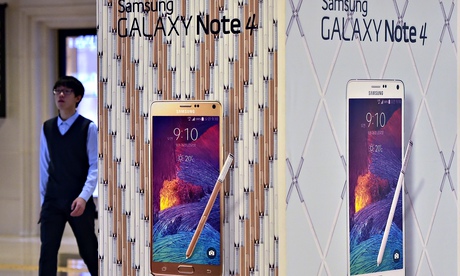
Profits at Samsung, the world’s biggest smartphone maker, collapsed in the third quarter as cheap Chinese brands ate into its share of the budget market and Apple’s iPhone sliced away at the top.
In a preview of full earnings due later this month, the South Korean company said that its quarterly operating profit will be around 4.1 trillion won (£2.3bn), the lowest in more than three years and far below analysts’ expectations of 5.2tn won. It would mark a 60% fall from the 10.2tn won recorded the year before.
The company blamed weak sales of its new Galaxy models in the period from July to the end of September. That followed a similarly weak showing in the previous quarter, when it said that stocks of unsold handsets built up with carriers. The company forecast that sales fell 20% from a year earlier to 47tn won, below analyst forecasts of 50.4tn won.
Samsung makes not only smartphones but also a dwindling number of “featurephones”, phone and computer displays, TV sets, PCs and semiconductor chips. Its vaulting profits in the past three years have partly relied on selling components for its own devices, so that a larger number of phones sold has benefited the display and chip businesses.
But aggressive marketing and sales by local brands in China and India, two of the largest and fastest growing smartphone markets, have pushed Samsung out of its top position there. Meanwhile in the US, another key market, Apple’s introduction of the larger-screened iPhone 6 and 6 Plus in mid-September may have lured some would-be Galaxy buyers away. High marketing costs have also eaten into profits. Quarterly profit from Samsung’s mobile business, which reached 6.7tn won a year earlier, is forecast to be a little over 2tn won.
“The operating margin declined due to increased marketing expenditure and lowered average selling price,” Samsung said in a statement. The company said it “cautiously expects increased shipments of new smartphones and strong seasonal demand for TV products”.
Analysts say the bigger iPhones released last month will likely take away American customers who favoured the Galaxy’s bigger screens. In emerging markets such as India and China, Samsung’s smartphone sales were overtaken by local rivals.
Jan Dawson, who runs the independent Jackdaw Research, said: “Samsung is facing an uphill battle in every part of its mobile business. At the high end, it faces stronger competition than ever from Apple and some emerging (and reemerging) Android-based players such as LG and Xiaomi. In China in particular, the Chinese brands are getting ever stronger and more competitive, and it will be hard for Samsung to regain momentum and set itself apart there without a radical shift in strategy.”
Tom Kang, of Hong Kong-based Counterpoint Research, said Samsung could still thrive: “It still has time, as that’s one of the advantages of being number one. People are reluctant to flock to an alternative all at once but Samsung should get its strategy straightened out soon. It has been throwing the same course repeatedly and getting pounded by the same player Apple each time. It shouldn’t be stubborn; it can just pass over the star player and compete with the next in line. It can still win the game if it swallows its pride.”
The company needs to revamp its handset designs, said Lee Seungwoo, an analyst at IBK Securities Co.
“Rather than seeking stability, Samsung should seek to distinguish [its phones] with Galaxy’s design policies,” he said. “The iPhone 6 will be a significant threat to Samsung.”
The company brought forward the launch of its large-screened Galaxy Note 4, a large smartphone with a stylus, to late September from October after Apple unveiled the iPhone 6, and began selling the Galaxy Note 4 in China last month, getting an early start in the world’s most populous country before Apple’s new devices go on sale there on 17 October.
With its momentum in smartphones sagging, Samsung is moving to step up its presence in the semiconductor business.
This week, it announced a 15.6tn won investment plan to build a new semiconductor fabrication plant in the South Korean city of Pyeongtaek. The construction will begin before the summer next year and begin operations during the second half of 2017.
Dawson said: “As the vast majority of future global growth in smartphones will come from low-end customers spending under $150 on a handset, it’s going to be really tough for Samsung to get going again. I see its investment in chip manufacturing as a sign that it’s looking beyond handsets for future growth, and that it would like to be a preferred supplier of chips for handsets if it can’t maintain its current share in devices. But that’s never going to make up the difference, and it faces fierce competition there both from incumbents and new entrants from China.”
Last month, Samsung also received upbeat initial responses to its Galaxy Note Edge smartphone, a device with a curved side screen that can display weather, news, apps and other information. But the supply volume for the Edge smartphone will be limited, and unlikely to significantly boost its earnings, analysts said.
Samsung does not disclose net income or divisional earnings in its quarterly earnings preview.

